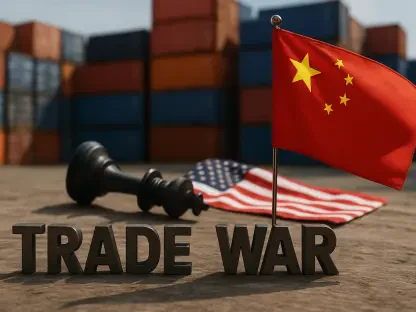In today’s interview, we have the pleasure of speaking with Priya Jaiswal, an esteemed expert in banking, business, and finance, who will be sharing her insights on the current economic climate. With the US and China engaging in a tariff battle, the repercussions are being felt worldwide. As Priya is well-versed in market analysis and international business trends, she is uniquely qualified to break down the impacts of these recent developments and what they mean for economies like Macao.
What recent developments in trade tariffs has the White House announced this month?
The White House recently implemented a series of trade tariffs aimed at various goods, which has created substantial uncertainty in the market. These tariffs are part of a broader strategy of reciprocal measures, which has only added to the confusion with unexpected pauses and exceptions.
How has the introduction of reciprocal tariffs added to the current economic confusion?
The introduction of reciprocal tariffs has complicated the trade environment by making it difficult for businesses and analysts to forecast future conditions. The unpredictability of these measures, including pauses and partial exemptions, has led to an environment where planning and stability are hard to achieve.
Can you explain why Macao is unlikely to escape the economic fallout from these tariff proposals?
Although Macao has minimal direct trading links with the US, it is still likely to experience economic fallout due to its close economic ties with China. The ripple effects of the US-China trade tensions are far-reaching and can affect global supply chains, consumer confidence, and investment flows.
What were the University of Macao’s initial GDP projections for 2025, and how did they change after the tariff announcement?
Initially, the University of Macao projected a 7.7% growth rate for GDP in 2025. However, following the announcement of the new tariffs, they adjusted their forecast down to 6.8%. This revision was prompted by the anticipated impact of US trade protection measures and ongoing structural adjustments in China.
Why did the University of Macao lower its GDP forecast for 2025?
The primary reasons for the lowered GDP forecast include concerns over US trade protectionism and significant structural changes in China’s economy. These factors could weigh heavily on Macao, which relies on Chinese tourism and investments for much of its economic activity.
How do foreign exchange rates operate and provide higher frequency data points than traditional economic readings?
Foreign exchange markets operate continuously through a network of traders and financial institutions, offering real-time data on currency values. This high-frequency information is in stark contrast to traditional economic readings, which typically come out monthly and can lag behind current events.
What economic principle explains the relationship between an importing country’s tariff and the exporting country’s response regarding currency value?
When an importing country imposes tariffs, the exporting country might devalue its currency to offset the increased costs for buyers, maintaining its competitive pricing. This economic principle helps stabilize trade volumes but can also lead to other economic consequences like inflation or capital flight.
How has the renminbi (RMB) trended against the US dollar since the tariff announcements?
Since the tariff announcements, the renminbi has generally weakened against the US dollar. This trend has been influenced not only by the tariffs but also by the slow recovery of the Chinese property market and other internal economic challenges.
What is the significance of the consumer price index (CPI) in measuring inflation?
The consumer price index (CPI) is crucial for measuring inflation because it tracks the price changes of a standardized basket of goods and services. These changes reflect the cost of living and purchasing power, influencing everything from wage adjustments to economic policy decisions.
How might expectations of rising costs lead to pre-emptive price increases and inflationary pressures?
When businesses anticipate rising costs, they often raise their prices in advance to mitigate the impact on their margins. This can lead to inflationary pressures as higher prices ripple through the economy, affecting consumer behavior and overall economic stability.
Why is low inflation preferred over deflation in an economy?
Low inflation is generally preferred because it signifies stable, predictable price increases that encourage spending and investment. Deflation, on the other hand, can lead to a downward spiral where decreasing prices reduce consumer spending and business investment, leading to economic stagnation.
What does the producer price index (PPI) measure, and how does it differ from the CPI?
The producer price index (PPI) measures the average change in selling prices received by domestic producers for their output. Unlike the CPI, which tracks consumer prices, the PPI focuses on the wholesale price levels, providing insights into the supply side of the economy and manufacturing costs.
Why might the PPI be important in understanding manufacturing prices in a slowing economy?
In a slowing economy, the PPI is significant because it reveals whether producers are reducing their prices to maintain sales volumes. This can indicate challenges in maintaining profit margins and provide early warnings of broader economic issues.
What is a purchasing managers index (PMI), and how is it conducted?
A purchasing managers index (PMI) is a survey conducted among managers in the manufacturing, services, and construction sectors. It captures their sentiment on business conditions, such as new orders, inventory levels, and employment, providing a snapshot of the economic health from the perspective of those making purchasing decisions.
How does the PMI reflect business sentiments and economic conditions?
The PMI reflects business sentiments by capturing managers’ perceptions of current economic conditions, including production volumes, supplier deliveries, and business outlooks. A PMI above 50 indicates expansion, while below 50 suggests contraction, making it a key barometer of economic activity.
Why might PMI surveys be considered leading indicators?
PMI surveys are often considered leading indicators because they provide early insights into business conditions and future economic trends. As they reflect real-time decisions made by managers, they can predict how businesses are likely to perform in the near term before official economic data is available.
What can a rapidly depreciating currency imply for consumer confidence and local household purchases in Macao?
A rapidly depreciating currency can erode consumer confidence by increasing the cost of imports and reducing purchasing power. For Macao, this could mean that local households might prefer to shop in mainland China where goods become relatively cheaper, reducing domestic economic activity.
How might higher tariffs on goods impact inflation rates within Macao’s economy?
Higher tariffs are likely to increase the cost of imported goods, which can lead to broader inflationary pressures as businesses pass on these costs to consumers. In Macao, this could make basic necessities more expensive, straining household budgets and dampening economic growth.
Given the lack of a PMI for Macao, how can data from China and the US still inform Macao’s economic outlook?
Even though Macao lacks its own PMI, the data from China and the US can still offer valuable insights. These countries are major economic influencers, and their PMI readings can indicate global economic trends, helping Macao anticipate and respond to broader market shifts that could affect its economy.
Do you have any advice for our readers?
My advice would be to stay informed and agile. The current economic environment is highly volatile, and informed decision-making can help you navigate these uncertain times. Diversifying investments and keeping an eye on macroeconomic indicators can offer a buffer against economic shocks.









